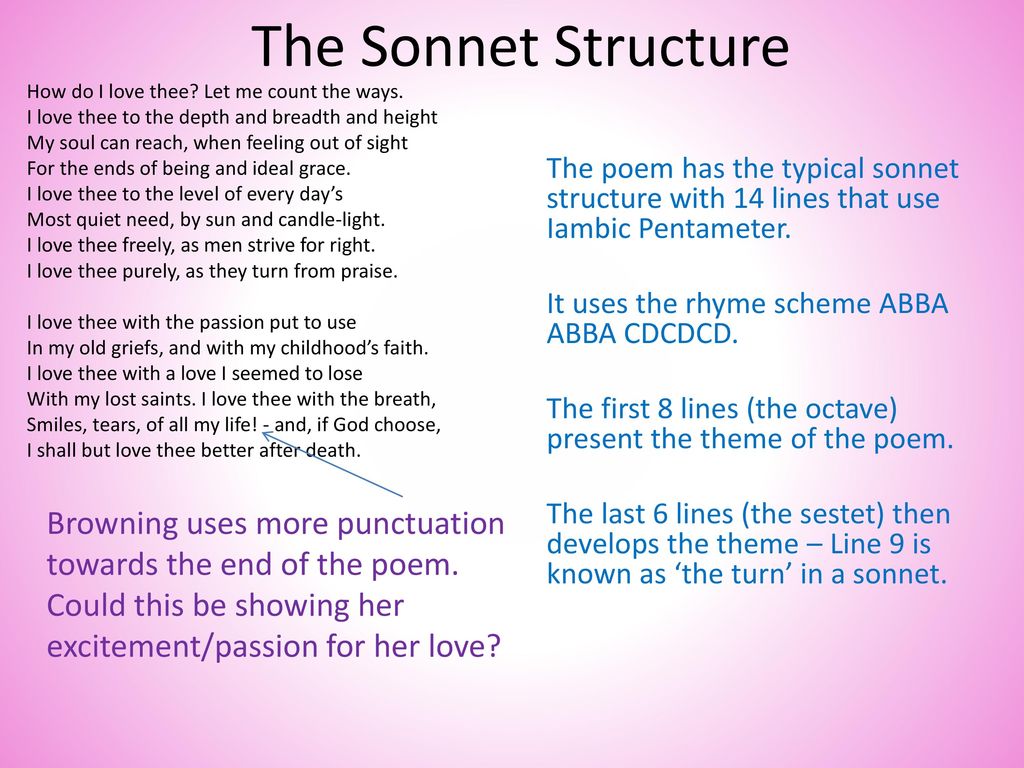
Sonnet 43 A Sonnet is a poem of 14 lines of forming rhythmic schemes. It is her most famous and best-loved poem having first appeared as sonnet 43 in her collection Sonnets from the Portuguese 1850.
Brownings sonnet is an ultimate profession of love that encompasses her whole being.
Elizabeth browning sonnet 43 analysis. Sonnet 43 by Elizabeth Barrett Browning describes the love that one speaker has for her husband. She confesses her ending passion. It is easily one of the most famous and recognizable poems in the English language.
In the poem the speaker is proclaiming her unending passion for her beloved. How Do I Love Thee. Is sonnet number 43 taken from The Sonnets From the Portuguese a book first published in 1850.
Elizabeth Barrett Browning chose this title to give the impression that she had translated the work from the Portuguese and would therefore avoid any controversy. It was dedicated to her husband poet Robert Browning. Sonnet 43 is an Italian sonnet a fourteen-line iambic pentameter poem written in a specific rhyme scheme.
The first line of the poem asks a question. The other thirteen lines answer it. Sonnet 43 A Sonnet is a poem of 14 lines of forming rhythmic schemes.
Sonnet 43 sound like this poem is one out of 43. That this poem is nothing special. Not special enough to have a more unique title to differentiate itself from Brownings other works.
Browning chose to use the Petrarchan sonnet form for Sonnet 43. It has a tighter rhyme scheme ABBA ABBA CDCDCD requiring only four sounds to end all fourteen lines a Shakespearean sonnet requires seven different sounds arranged in an ABAB CDCD EFEF GG pattern The unity of sound suggests closeness and intimacy both of which she comes to share with Robert. In any case Sonnet 43 comes towards the end of the series and as such inevitably possesses a climactic appeal when read in context with the other sonnets.
This essay will briefly discuss the genre and other technicalities of this particular poem before analysing it in more detail to determine its impact and effect up on the reader. The entire sonnet addresses this lover thee who may also be considered the listener. As it is known that Elizabeth Barrett Browning dedicated this poem to her husband she is assumed to be the speaker addressing her husband.
The speaker describes all the ways in which she loves her husband. In Sonnet 43 Elizabeth Browning is writing a testament of the love for her husband-to-be Robert Browning. A sonnet is derived from the Italian word sonneto literally little song mainly expressing love.
Brownings sonnet is an ultimate profession of love that encompasses her whole being. Sonnet 43 is a love poem written from the perspective of a woman to her lover. It is written in iambic pentameter and follows the Italian sonnet tradition in the style of Petrarch.
A Petrarchan sonnet contains 14 lines. An octet of eight lines followed by a sextet of six lines. How do I love thee.
Let me count the ways is a sonnet by the 19th-century poet Elizabeth Barrett Browning. It is her most famous and best-loved poem having first appeared as sonnet 43 in her collection Sonnets from the Portuguese 1850. Although the poem is traditionally interpreted as a love sonnet from Elizabeth Barrett Browning to her husband the poet Robert Browning the speaker and addressee are.
The tone of the poem is the mood that the message conveys. The sonnet simply expresses the intimate loving and sincere aspects of the sonnet. Throughout the poem the poet includes a significant amount of imagery in this sonnet.
I love thee to the depth and breadth and height. Analysis of Sonnet 43 Elizabeth Barrett Browning wrote Sonnet 43 during the prime of the Victorian Period which lasted the duration of Queen Victorias throne between 1832 and 1901. Like some of the works during the Victorian period Sonnet 43 was a reflective piece about the love of.
An Analysis of Elizabeth Barrett Brownings How Do I Love Thee How do I love thee by Elizabeth Barrett Browning is the 43rd sonnet from Sonnets from the Portuguese. Sonnet 43 is a romantic poem written by Elizabeth Barrett Browning. In the poem she is trying to describe the abstract feeling of love by measuring how much her love means to her.
She also expresses all the different ways of loving someone and she tells us about her thoughts around her beloved. The tone of the poem is deep in a loving way. For the ends of being and ideal grace.
I love thee to the level of every days. Most quiet need by sun and candle-light. I love thee freely as men strive for right.
I love thee purely as they turn from praise. I love thee with the passion put to use. In my old griefs and with my childhoods faith.
This video is the first part of my analysis of Sonnet 43 by Elizabeth Barrett Browning which is part of the WJEC Eduqas English Literature Poetry Antholog. The poems title is Sonnet 43 The word Sonnet means A verse form consisting of fourteen words with a fixed rhyme scheme. Because the title is very vague and only states the kind of poem it is there is no good guess as to what the poem is about and why it is called this.
Analysis of Sonnet 43 Elizabeth Barrett Browning wrote Sonnet 43 during the prime of the Victorian Period which lasted the duration of Queen Victorias throne between 1832 and 1901. Like some of the works during the Victorian period Sonnet 43 was a reflective piece about the love of her life Robert Browning. Elizabeth Browning showed this.
While Elizabeth Barrett Brownings Sonnet 43 from Sonnets from the Portuguese is a Petrarchan or Italian sonnet like the others in this collection it does not follow the traditional pattern.
